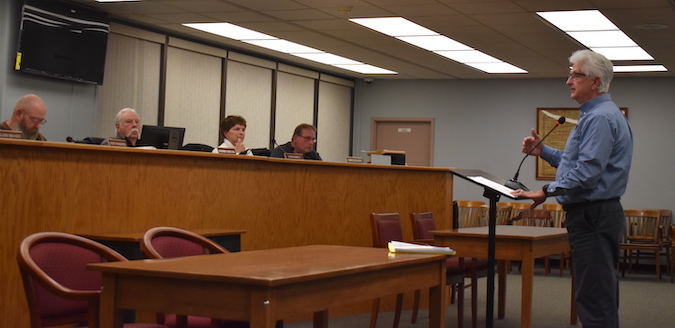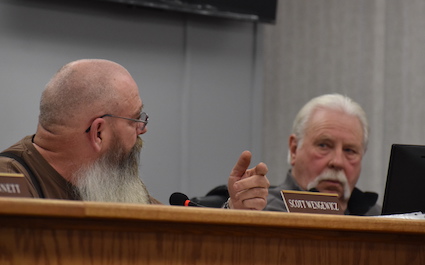Switching to Royalton for water would be costly for Shelby, Town Board told
Engineer says water pressure would also drop, dead-end waterlines remain

Photos by Tom Rivers: Paul Chatfield of the MRB Group says bringing in water to Shelby from the Town of Royalton would be costly to put in a new water tank, pump station and 9,200 feet of waterlines. He is speaking at a Shelby Town Board meeting on Thursday evening.
SHELBY – Shelby town officials want to see more details on whether it would be financially justified to put in new infrastructure to allow the town to buy lower-priced water from Royalton.
The town currently buys water from the Village of Medina, with a 24-inch transmission line going down Maple Ridge Road to a 3-million-gallon storage tank on 31A.
But the cost is $5.97 per 1,000 gallons to Shelby. Town Supervisor Scott Wengewicz said that is a high cost for town water users.
Wengewicz said the Royalton price would be $3, perhaps cutting water bills in half.
“I’m trying to lower peoples’ water rates,” he said. “We have some of the highest water around.”
But to get adequate supply from Royalton, the town would need to put in a booster pump station, a 250,000-gallon water storage tank and run 9,200 feet of waterlines on the west end of the town. That project was an estimated $5.4 million in 2020, engineer Paul Chatfield told the Town Board on Thursday evening.
Construction cost are up 50 percent in four years, which would put the project at about $8 million today.
The town likely wouldn’t receive grant funding for the project because it is keeping the same source of the water, with the Niagara County Water District as the supplier, Chatfield said. The change would be with Shelby buying from Royalton instead of Medina.

Town Supervisor Scott Wengewicz, left, wants a more detailed study on the costs. He believes the lower-priced water from Royalton could make the project worthwhile. Town Board member Steve Seitz is at right.
The federal government gives preference in funding projects if the water goes to residents on wells with contaminants or if there is a lack of quantity and poor water quality, said Scott Mattison, an engineer with MRB.
If the town had a consent order from the Department of Health or Department of Environmental Conservation that would help with a grant application to help pay for public water, Mattison said.
Shelby’s push to put in infrastructure for water from Royalton isn’t focused on improved water quality.
“Your just switching who you pay,” he said. “It’s the same source.”
(The Town Board would like to expand waterlines to serve areas on wells – Sanderson Road, Martin Road to Bigford, and a section of Salt Works Road to Hemlock Ridge Road.)
Wengewicz said if the town was able to get water from Royalton, Shelby would continue to use Medina for Maple Ridge Road and properties north of Maple Ridge. He would like a hybrid system, with water from medina and Ridgeway.
The engineers from MRB said the two systems have vastly different water pressure in the lines. Medina’s is about 80 pounds per square inch while Royalton is about 40 PSI. The Royalton system would need a significant pressure booster to match Medina’s. If Medina’s dropped down to 40 PSI the existing customers would notice the weaker water pressure and wouldn’t be happy about it, Chatfield said.
The weaker pressure would also impact the fire flow in the system, he said.
“This it not a simple switch,” Mattison said about changing over some of the system to Royalton water.
The town’s water system currently has several dead-end mains which require flushing. Using all that water to flush out the lines is costly, Wengewicz said.
The town buys about 65 million gallons of water a year from Medina. Flushing accounts for about 2.3 million of those gallons.
A change to Royalton would still result in dead-end lines, with flushing needed, Chatfield said.
Looping lines and closing the dead spots is the best way to keep the water moving, as well as having properly sized water lines. If the lines are too big, the water can sit there, he said.
Chatfield also said there was 27 percent water loss in the system due to leaks when it was studied in 2020. He suggested a water leak detection program to help find the leaks. If those were fixed that would cut down on the water loss. Wengewicz said the Highway Department has found and repaired some leaks to reduce the amount of loss.
Chatfield and Mattison said a more in-depth analysis is needed to help the board make a decision on whether the potential water savings justify the expense of new infrastructure. The board also has discussed the issues with Clark Patterson Lee, another engineering firm. Shelby may draw up a request for proposals and have the firms submit their scope of work and a cost for the services, as well as detailed estimates on the cost of a water storage tank, pressure boosters, and any new waterlines.
For Shelby to receive water from Royalton, 9,200 linear feet of a waterline would have to go from Griswold Road in Royalton to Chestnut Ridge Road. It would connect on West Shelby Road. A new water tank would be needed, and a booster pump to maintain pressure and move the water through the lines.







































































